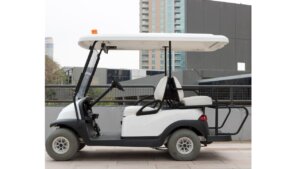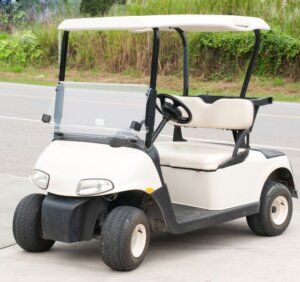
Unlock the joy of recreational rides! Whether you’re a golf enthusiast or cruising your community, mastering “How to Start a Golf Cart” is essential. Our step-by-step guide guarantees a smooth and safe journey every time. Start your golf cart adventure with confidence!
Read also: How Old to Rent a Golf Cart? – 2024
How to start a golf cart for beginners
Cruising around the course in a golf cart is a quintessential part of the golfing experience. But for newbies, navigating the startup process can be as daunting as a tricky bunker shot. Worry not, fellow️♀️, because this guide will equip you with the knowledge to fire up your cart confidently and hit the links in no time!
Know Your Cart:
First things first, familiarize yourself with your trusty steed. Golf carts come in two main flavors: electric and gas-powered.
- Electric Carts: These whisper-quiet chariots are powered by batteries, making them eco-friendly and perfect for smooth, leisurely rides. Think of them as the gliding Teslas of the fairway.
- Gas-Powered Carts: These louder, zippier carts pack a punch with their gasoline engines. They’re ideal for tackling hilly courses or hauling your clubs and snacks like a champ. Consider them the rugged Jeeps of the green.

Pre-Flight Checkup:
Before you embark on your golfing adventure, ensure your cart is ready for takeoff with a quick pre-ride inspection:
- Tire Time: Check the air pressure and tread depth of your tires. Bald tires are no fun on uneven terrain, and proper inflation ensures a smooth ride.
- Brake Check: Give the brakes a gentle squeeze to test their responsiveness. If they feel spongy or unresponsive, get them checked out before hitting the course.
- Fluid Frenzy: For gas carts, peek at the oil and coolant levels. For electric carts, keep an eye on the battery gauge. Top things off if needed.
- Lighten Up: Check that your headlights, taillights, and turn signals are all in working order. Safety first!
Starting Your Engine:

Now, the moment of truth! The starting procedure will differ slightly depending on your cart’s power source:
-
Electric EZ:
- Insert the key and turn it to the “On” position.
- Make sure the accelerator pedal is pressed down slightly.
- Turn the key to “Start,” and listen for the gentle whirring of the electric motor. You’re good to go!
-
Gas-Powered Gumption:
- Engage the parking brake to avoid any runaway cart mishaps.
- If the engine is cold, pull out the choke knob (usually a small lever near the steering wheel).
- Turn the key to the “On” position to activate the electrical system.
- Press the accelerator pedal slightly to prime the engine.
- Turn the key to “Start” and listen for the satisfying roar of the engine coming to life. Release the choke gradually as the engine warms up.
Hitting the Road (or Course):
Once your cart is purring, familiarize yourself with the basic controls:
- Steering Wheel: This one’s pretty self-explanatory – use it to navigate the course and avoid sand traps and grumpy golfers.
- Accelerator Pedal: Gently press this pedal to increase speed. Remember, slow and steady wins the race (and avoids bumpy rides).
- Brake Pedal: Apply this pedal gradually to slow down and come to a complete stop. Don’t slam on the brakes, unless you want to reenact a dramatic movie scene (not recommended).
Etiquette and Safety Tips:
Remember, you’re not alone on the course. Be a courteous cart-mate by following these simple guidelines:
- Horn Honking: Use the horn sparingly, and only when necessary. Nobody enjoys surprise honks while lining up a putt.
- Pace Yourself: Don’t speed around like a Formula One racer. Maintain a safe and considerate pace, especially near pedestrians and other carts.
- Sharing is Caring: Offer rides to fellow golfers if they need a lift (especially uphill!). Sharing is the ultimate birdie on the course of sportsmanship.
Maintaining Your Cart:
Just like any vehicle, your golf cart needs regular TLC to keep it running smoothly. Here are some key maintenance tips:
- Regular Checkups: Schedule yearly checkups with a qualified mechanic for both electric and gas-powered carts.
- Battery Love: For electric carts, keep the battery charged and clean. Avoid leaving it completely drained for extended periods.
- Oil Changes: For gas carts, follow the manufacturer’s recommendations for oil changes and other routine maintenance.
Bonus Tips:
- Transporting Your Cart: If you need to transport your cart, use a trailer or truck specifically designed for golf carts. Don’t attempt to squeeze it into the back of your sedan!
- Customizing Your Ride: Add some personality to your cart with fun accessories
Read also: How Fast Can a Golf Cart Go?
How to start an EZGO golf cart
The starting procedure for an EZGO golf cart will vary slightly depending on the model and year, but the general steps are as follows:
Before you start:
- Make sure the parking brake is engaged. This is essential for safety, as it prevents the cart from rolling away unexpectedly.
- Check the battery level. A weak battery can prevent the cart from starting. If you’re unsure about the battery level, you can use a voltmeter to check it.
- Clear any debris from around the engine and exhaust. This is especially important if you’ve been storing the cart for a while.
Starting the cart:
- Insert the key and turn it to the “ON” position.
- Select the gear you want to use (forward or reverse).
- Press the accelerator pedal slowly.
Additional tips:
- If the cart doesn’t start right away, don’t hold the starter motor for more than five seconds at a time. Let it cool down for a few seconds before trying again.
- If the cart still doesn’t start, check the fuel level (if it’s gas-powered) or the battery connections.
- If you’re still having trouble, consult the owner’s manual or a qualified mechanic.
Here are some additional things to keep in mind:
- Some EZGO golf carts have a keyless ignition system. If your cart does, you’ll need to press the start button instead of turning a key.
- Some EZGO golf carts have a choke that you need to engage when starting the engine in cold weather.
- Always be aware of your surroundings when driving a golf cart. Golf carts are not street-legal in most places, so it’s important to obey all traffic laws and be extra cautious around pedestrians and vehicles.
I hope this helps! Let me know if you have any other questions.

Read also: How to Make a Golf Cart Faster 2024
Choosing the Right Golf Cart
Before diving into the starting process, it’s essential to choose the right golf cart for your needs. There are various types available, including electric and gas-powered carts. Consider factors such as usage, terrain, and maintenance requirements to make an informed decision.
Getting Familiar with the Golf Cart Components
To start a golf cart confidently, it’s crucial to familiarize yourself with its components. From the battery to the motor, understanding how each part contributes to the cart’s functionality ensures a smoother overall experience.
Safety Precautions Before Starting
Safety should always be a priority when dealing with any vehicle, and golf carts are no exception. Before starting your cart, perform a quick safety check, ensuring that brakes, lights, and other essential components are in good working condition.
Understanding the Ignition System
Golf carts come with unique ignition systems that differ from traditional vehicles. Gain insight into how these systems operate to avoid common mistakes and potential issues down the road.
Turning the Key: Step-by-Step Guide
The process of starting a golf cart often begins with a key. However, there’s more to it than simply turning the key. We’ll walk you through the steps, highlighting important considerations for a seamless start.
1. Pre-Check: Ensure Your Cart is Ready
Before turning the key, take a moment for a quick pre-check. Confirm that the parking brake is engaged, and the gear lever is in the neutral position. This precautionary step helps prevent any unintended movement when the cart starts.
2. Inserting the Key: Precision Matters
Locate the ignition key slot, typically located on the dashboard or steering column. Insert the key carefully, ensuring it goes all the way in. A secure fit is essential for proper engagement with the ignition mechanism.
3. Adjusting the Steering Wheel: Ease of Key Insertion
In some golf carts, the steering wheel may have a lock mechanism that engages when the key is removed. If you find resistance when inserting the key, gently turn the steering wheel left or right to release the lock. This adjustment allows for smoother key insertion.
4. Battery Activation: Understand Your Cart Type
Different golf carts have varying ignition systems. Electric carts, for instance, might not require the traditional turning of the key to activate the battery. Understand the specifics of your cart’s ignition system to avoid unnecessary steps.
5. Ignition Switch Position: Know the Stages
Once the key is inserted, pay attention to the ignition switch positions. In many carts, there are multiple stages, including Off, On, and Start. Turn the key clockwise to the “On” position first, allowing electrical systems to activate without starting the engine.
6. Listening for Sounds: Diagnosing Issues
While in the “On” position, listen for any unusual sounds or clicks. This step helps identify potential issues with the ignition system or the battery. If you hear any abnormal noises, it’s advisable to investigate further before proceeding.
7. Engaging the Starter: Turning to the “Start” Position
With the key in the “On” position and after ensuring everything sounds normal, turn the key further clockwise to the “Start” position. This action engages the starter motor, initiating the engine’s ignition process.
8. Hold Until the Engine Starts: Patience is Key
In the “Start” position, hold the key for a few seconds until the engine starts. Most modern golf carts have a built-in safety feature that prevents damage by disengaging the starter after the engine is running. Be patient during this brief period.
9. Release the Key: Returning to the “On” Position
Once the engine starts, release the key, allowing it to return to the “On” position. This step ensures that the starter disengages and the engine continues to run smoothly.
10. Confirm Readings on the Dashboard: Monitor Indicators
Check the dashboard indicators to confirm that the cart is running optimally. Ensure that battery levels, fuel (if applicable), and any other relevant readings are within normal ranges.
By following this detailed step-by-step guide, you’ll not only start your golf cart with confidence but also develop a routine that promotes the longevity of your cart’s ignition system. Remember, precision and attention to detail are key when turning the key on your golf cart. Happy driving!
Dealing with Electric Golf Carts
Electric golf carts have their nuances, including charging considerations. Learn the specifics of starting and maintaining electric carts for optimal performance.
Starting Gas-Powered Golf Carts
For those with gas-powered carts, understanding the starting process and regular maintenance tasks is essential. We’ll guide you through the steps and provide tips for keeping your gas-powered cart in top shape.
Troubleshooting Common Starting Issues
Even with proper maintenance, golf carts can encounter starting issues. Explore common problems and troubleshooting steps to address issues like dead batteries or ignition problems.
Regular Maintenance for Smooth Operations
Preventive maintenance is key to the longevity of your golf cart. Discover simple tasks that you can perform regularly to keep your cart operating smoothly.
Storage and Winterization Tips
If you plan to store your golf cart during the off-season, we’ll provide guidelines for proper storage and winterization to prevent any potential damage.
Upgrading Your Golf Cart
For those looking to personalize their carts, we’ll explore customization options and upgrades. Enhance both performance and aesthetics to suit your preferences.
Understanding Local Regulations
Before hitting the road with your golf cart, familiarize yourself with local laws and regulations. From permits to safety requirements, staying informed ensures a legal and enjoyable experience.
Read also: Golf cart
Joining the Golf Cart Community
Being part of a golf cart community comes with its perks. Learn about the benefits of connecting with fellow enthusiasts, sharing experiences, and gaining valuable tips.
Environmental Considerations
As the use of golf carts expands, it’s essential to consider their environmental impact. We’ll discuss eco-friendly practices and how you can minimize your carbon footprint while enjoying your cart.
Conclusion
Starting a golf cart is a simple yet crucial skill for any owner. By following our comprehensive guide, you’ll not only master the art of starting your cart but also gain valuable insights into maintenance, safety, and community engagement. Embrace the freedom and convenience that a golf cart offers while being a responsible and informed owner.
In conclusion, as you embark on your golf cart journey, remember that knowledge and awareness go hand in hand with enjoyment. Take the time to understand your cart, follow safety guidelines, and contribute positively to the growing community of golf cart enthusiasts. Happy driving!
FAQs:
- Q: Do electric golf carts require special charging stations?
- A: In most cases, electric golf carts can be charged using a standard electrical outlet. However, some models may have specific charging requirements. Always refer to your cart’s manual for accurate information on charging.
- Q: What should I do if my gas-powered golf cart won’t start?
- A: First, check the fuel level and ensure the choke is in the correct position. If the issue persists, inspect the spark plug and battery. If you’re still experiencing problems, it’s advisable to consult with a professional mechanic.
- Q: Can I upgrade my golf cart’s battery for extended range?
- A: Yes, upgrading your golf cart’s battery is a common practice to extend range and improve performance. However, ensure compatibility with your cart model and consult with experts to make informed choices.
- Q: Are there speed limits for golf carts on public roads?
- A: Speed limits for golf carts vary by location. In many cases, local regulations apply, and it’s essential to adhere to posted speed limits. Always be aware of your surroundings and prioritize safety on public roads.
- Q: What safety gear is recommended when using a golf cart?
- A: Essential safety gear includes a helmet, especially for off-road or high-speed use. Additionally, consider using seat belts, proper footwear, and eye protection. Always follow the safety guidelines provided by the cart’s manufacturer.









